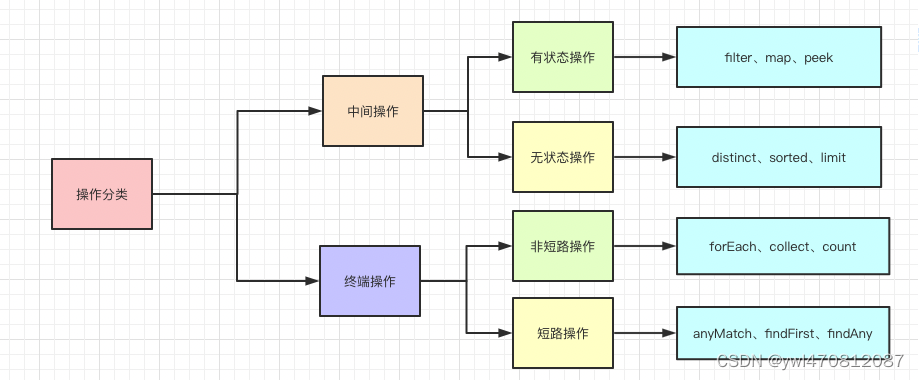简介:Stream 中文称为 “流”,通过将集合转换为这么一种叫做 “流” 的元素序列,通过声明性方式,能够对集合中的每个元素进行一系列并行或串行的流水线操作。
操作分类:

.stream()
stream()把一个源数据,可以是集合,数组,I/O channel, 产生器generator 等,转化成流
常见流操作API
中间操作
.filter()
filter()方法用于通过设置的条件过滤出元素
.map()
map()用于映射每个元素到对应的结果
.sorted()
sorted()用于对流进行排序
distinct():去除重复的元素
終端操作:
forEach():遍历每个元素。
findFirst()
findFirst()用于找到第一次出现的元素
reduce():把Stream 元素组合起来。例如,字符串拼接,数值的 sum,min,max ,average 都是特殊的 reduce。
collect():返回一个新的数据结构,基于Collectors有丰富的处理方法。Collectors类实现了很多归约操作,例如将流转换成集合和聚合元素。Collectors 可用于返回列表或字符串,collect()内可以用collectors进行转换:
min():找到最小值。
max():找到最大值。
中间操作:中间操作包括去重、过滤、映射等操作,值得说明的是,如果没有为流定义终端操作,为了避免无谓的计算,中间操作也不会执行
终端操作:终端产生最终的执行结果,并中断流式编程的衔接链,因此结束操作是最后一个操作
.collect(Collectors.toList());//列表
.collect(Collectors.joining(", "));//字符串.isPresent()
isPresent()可以判断所找到的值是否是null
.orElse()
orElse(null)表示如果一个都没找到返回null
orElse()中可以塞默认值。如果找不到就会返回orElse中你自己设置的默认值。
补充:
Optional<T> findFirst()
findFirst方法返回Optional包含流中第一个元素的元素,如果findFirst选择的元素为null,它将抛出NullPointerException
所以推荐将findFirst与orElse连用规避空指针的问题,如下所示:
A a = AList.stream().filter(a -> "小明".equals(a.getUserName())) .findFirst().orElse(null);
举例
import java.util.ArrayList;
import java.util.List;
import java.util.stream.Collectors;public class StreamOperation {public static void main(String[] args) {List<StudentVO> list = initList();testFilter(list);}private static List<StudentVO> initList(){List<StudentVO> list = new ArrayList<>();StudentVO student1 = new StudentVO();student1.setKey("a");student1.setValue("str-a");student1.setName("李四");student1.setSex("男");list.add(student1);StudentVO student2 = new StudentVO();student2.setKey("b");student2.setValue("str-b");student1.setName("张三");student1.setSex("女");list.add(student2);StudentVO student3 = new StudentVO();student3.setKey("c");student3.setValue("str-c");student1.setName("小红");student1.setSex("女");list.add(student3);return list;}private static void testFilter(List<StudentVO> list){List<StudentVO> listNew = list.stream().filter(item->item.getKey().equals("a")).collect(Collectors.toList());listNew.forEach(studentVO->{System.out.println(studentVO.getKey());System.out.println(studentVO.getValue());});List<StudentVO> bList = list.stream().filter(item->item.getKey().equals("b")).collect(Collectors.toList());bList.forEach(studentVO->{System.out.println(studentVO.getKey());System.out.println(studentVO.getValue());});}}
1,filter

2,map
3, sorted排序
private static void testSorted(List<DemoVO> list){//自然排序,先对key进行排序,再对value进行排序。List<DemoVO> collect = list.stream().sorted(Comparator.comparing(DemoVO::getKey).thenComparing(DemoVO::getValue)).collect(Collectors.toList());System.out.println(JSON.toJSONString(collect));collect = list.stream().sorted(Comparator.comparing(DemoVO::getKey).thenComparing(DemoVO::getValue)).collect(Collectors.toList());System.out.println(JSON.toJSONString(collect));
}输出结果:
[{"key":"a","value":"str-a"},{"key":"b","value":"str-b"},{"key":"c","value":"str-c"}]4,去重
//去重private static void testDistinct(List<StudentVO> list){List<StudentVO> collect = list.stream().distinct().collect(Collectors.toList());System.out.println(JSON.toJSONString(collect));}//输出结果
[{"key":"a","value":"str-a"},{"key":"b","value":"str-b"},{"key":"c","value":"str-c"}]5.List<Object>转List<attribute>
private static void convertToList(List<DemoVO> list){List<String> collect = list.stream().map(DemoVO::getValue).collect(Collectors.toList());System.out.println(JSON.toJSONString(collect));
}//输出结果
["str-a","str-b","str-c"]








![[C/C++]BKDRHash](http://pic.xiahunao.cn/[C/C++]BKDRHash)


!)







